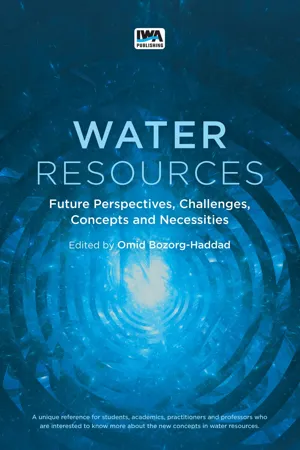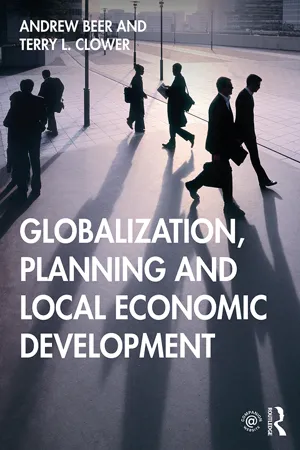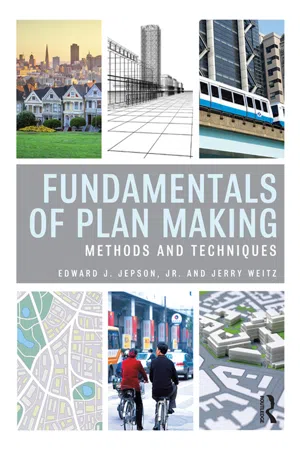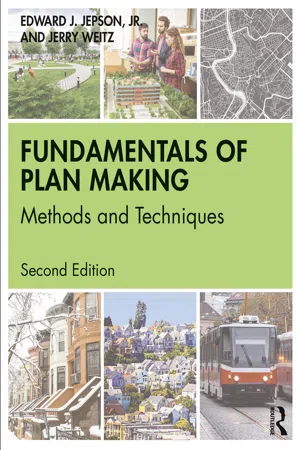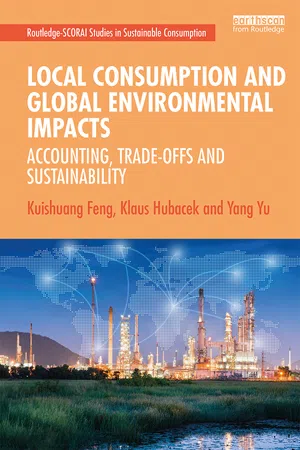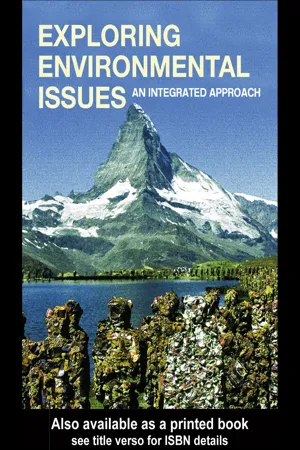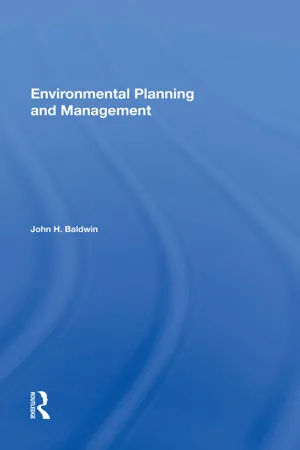Geography
Land Use
Land use refers to the human activities and purposes for which land is utilized, such as residential, commercial, agricultural, or industrial. It encompasses the spatial organization and management of land resources, including zoning regulations, urban planning, and environmental conservation. Understanding land use patterns is crucial for analyzing human-environment interactions and the sustainable development of landscapes.
Written by Perlego with AI-assistance
Related key terms
Related key terms
1 of 4
Related key terms
1 of 3
10 Key excerpts on "Land Use"
- Omid Borzog-Haddad(Author)
- 2021(Publication Date)
- IWA Publishing(Publisher)
Land Use planning is defined as the regulation of the relationship between space and human activities. Space occupied by human settlements, farmland and forests, parks, fallow land, rivers and lakes, and by transportation networks constitutes a network of areas dedicated to Land Uses such as agriculture, forestry, rangeland, industry, mining, recreation, and fishing. Land Use planning is a comprehensive and long-term approach to planning human relations and their activities in space; it is the task of regulating and coordinating the strategies and general orientations of sectors, and it is the foundation of economies and human activities. The purpose of Land Use planning is to achieve an optimal distribution of economic and social activities. Land Use selection and management are commonly done without regard to the carrying capacity of the land which, when exceeded, results in economic losses and in a reduction of environmental quality. The overall goal of Land Use planning is to achieve the optimal use of the land within the national interest framework. Accordingly, formulating a successful plan for managing the development of a country requires proper attention to the roles of geography and Land Use. Creation of a suitable balance between the Earth and its use by human activities can be achieved by proper land management. The increasing importance of environmental issues and human alteration of natural environments calls for sustainable development and Land Use practices that conserve natural resources while benefiting society and the environment. Nowadays, due to many factors such as climate change, population growth, changing standards of living, poverty, access to education, and mismanagement of natural and water resources, there is a need to diversify food and agricultural production in a variety of ways. Overseas cultivation is one of them, and it has potential for improving agricultural production. The practice of overseas cultivation by a country means planting and harvesting of a variety of agricultural products in other countries to be sold in its domestic market or in foreign markets. There are five basic principles that underline the success of overseas cultivation involving any group of countries: (1) mutual respect for the governance of all countries; (2) making and abiding by agreements between the countries; (3) non-interference in the internal problems of each country and respect for the territorial integrity of all countries; (4) optimal use of human resources and capacities to support agricultural activities and trade; and (5) expanding security and military cooperation.- Andrew Skidmore(Author)
- 2017(Publication Date)
- CRC Press(Publisher)
11Land Use planning and environmental impact assessment using geographic information systems
Egide Nizeyimana, Gary W. Petersen and Joan C. Looijen11.1 INTRODUCTIONLand Use planning consists of making decisions about the use of land and resources (Food and Agricultural Organization 1993). It is conducted primarily to achieve the best use of land, and its implementation is often driven by current and future people’s needs in terms of productivity and environmental sustainability. Land Use planning may not be as important in sparsely populated countries and communities. In sparsely populated countries or communities, the Land Use planning is straightforward and is usually aimed at finding the best locations for each of the potential Land Uses at hand; in other words, it is reduced to a land evaluation (FAO 1976; Rossiter 1996). In highly populated communities, however, Land Use planning consists of a more elaborate analysis due to conflicts between competing uses (Brinkman 1994). In this case, planning activities are tailored primarily to making the optimal uses of the limited land and associated resources.Land Use planning may be conducted at different levels or scales of decision-making: national, district, local, farm, or field level. The national level is concerned primarily with national priorities as driven by Land Use policy and legislation. In some countries, Land Use planning consists of a multi-year program detailing goals at every step of the action plan. Land Use planning at a district level often deals with development projects. Local planning may be carried out at the community or watershed level. Farm-level Land Use planning involves determining best management practices for different fields in the farm. The Land Use planning process differs from project to project depending on the goals and availability of data. Most projects involve sequential organization of thoughts, evaluation and comparison of alternative Land Uses in terms of their suitability and impacts to the environment, and finally design and implementation of the plan. While the Food and Agriculture Organization (FAO) Land Use planning process (Figure 11.1 ) emphasizes the regional and nationwide planning, that of the United States Department of Agriculture-Natural Resources Conservation Service (USDA-NRCS) is primarily concerned with conservation planning and nutrient management at the farm level (Figure 11.2- Andrew Beer, Terry L. Clower(Authors)
- 2019(Publication Date)
- Routledge(Publisher)
10 Land Use planning and economic developmentThis chapter:- ► Offers a brief review of the history of Land Use planning;
- ► Reviews traditional and emerging Land Use regulatory mechanisms and their existing and potential relationships with economic development;
- ► Considers new approaches to urban planning from an economic development perspective;
- ► Reviews the tools used to promote (economic) development in special needs areas.
Land Use PLANNING is collectively the processes used to research, evaluate, determine and regulate the use of land to meet societal goals. Not-withstanding recent events in the South China Sea and the history of the Netherlands, land is a precious commodity because 'we are not making any more of it' – as the saying goes. Balancing the allocation of land to economic uses, of all types, and the growing imperative to preserve natural environs is challenging, especially in a world where accelerating growth has pushed the global population to more than 7.4 billion. While many call for the protection of pristine environments, Land Use, in one way or another, forms the basis of almost all economic activity. The built environment represents 85 percent of the total capital stock in OECD nations (Krawchenko and Schumann 2017).There is a general view, at least in the United States and in other nations such as the UK, New Zealand and Australia, that Land Use planning is focused on reducing the negative spillover effects of economic activity, correcting for unregulated market forces, while also addressing sociopolitical issues (Kim 2011; Sayce and McIntosh 2002). It is not seen to prioritize supporting economic development and wealth creation. However, some nations including France, Ireland, Germany, among others, use economic planning as the main means for regulating Land Use including architectural features, urban design and other controls on the built environment (Silva and Acheampong 2015).- eBook - ePub
Fundamentals of Plan Making
Methods and Techniques
- Edward J. Jepson, Jr., Jerry Weitz(Authors)
- 2015(Publication Date)
- Routledge(Publisher)
9 Land-Use Analysis After reading this chapter, you will be able to:- describe how the land-use element interrelates with other elements of a local comprehensive plan;
- recite the major purposes of different types of land-use maps, including existing Land Use, future Land Use, and the official zoning map;
- place an individual Land Use on a land-use compatibility continuum; and
- estimate the number of acres of residential land needed to accommodate population growth, and estimate the amount of land needed to serve nonresidential uses based on employment projections.
Relationship of Land Use to Community Development and Comprehensive Planning
The land-use element can be viewed as the culmination of all the other elements of a local comprehensive plan. It is the way that a community’s population, economic, and environmental characteristics, current and projected, can be accommodated within a space that is limited yet flexible in terms of how it might be used. As such, the land-use element has been described as the arena where a “high stakes game” among the various land-use interests in a community are played out (Berke et al. 2006: 4–5) and ultimately created through the unfolding character of its landscape. It is also the element that falls most directly under the regulatory scope of planning.Planning Interrelationships
Natural Environment and Resources
The natural resources element is prepared in support of sound land-use planning for environmental protection. As growth management expert Douglas Porter (2008) has indicated, an inventory of natural limitations on Land Use should be completed for the purpose of determining where “not to grow.” And as Ian McHarg (1969) suggests, Land Use can only be planned with environmental stewardship in mind if adequate inventories of natural conditions such as soils, hydrology, and geology are prepared and analyzed for their respective limitations on land development. Areas in the planning area that are sensitive environmentally, or “critical” due to hazards, are characterized in land-use plans as “conservation” Land Uses. - eBook - ePub
Fundamentals of Plan Making
Methods and Techniques
- Edward J. Jepson, Jr., Jerry Weitz(Authors)
- 2020(Publication Date)
- Routledge(Publisher)
After designating areas where the community does not want to grow or should not grow, and after designating lands where the community wants development to occur, the land-use planner is left with a number of “remainder” tracts of land that don’t fit neatly into the “where to grow” or “where not to grow” dichotomy. Determining the appropriate future Land Use for these lands will take a more concerted study and may be influenced by numerous factors, including: land-use needs; suitability of the land for one or more Land Uses; market trends; guidance from the community vision and land-use policies; efforts to ensure “compatibility” or transitions among Land Uses; efforts to reconcile land-use problems; and the influence of everyday politics (i.e., property owner advocacy, recommendations of the planning commission, and decisions of the locality’s governing body).Approaches to Future Land-Use Design
The aim of future land-use design is to help a community develop its land in a way that is consistent with its inherent physical character and collective values. Typically, a community’s land-use design is the result of an iterative process through which professional skills are combined with community vision. In the following section we present the mechanics of three different approaches to land-use design without defining the values that are driving it and which will emerge during the plan-making process (Chapter 10 ).2Define Land-Use Categories
The land-use design map portrays the future urban form as a pattern of residential, institutional, office, retail/service commercial, industrial, and open spaces (Kaiser and Godschalk 1995). Land-use categories can differ remarkably among rural, suburban, and urban planning areas. For instance, in rural areas, agriculture is likely to be a land-use classification, whereas agriculture may be nonexistent in some urban areas. Listed below are categories that may be found in an existing land-use or future land-use map.- Vacant or undeveloped : open field or wooded, no building or other development improvement exists. Note:for future land-use maps, this designation will be used sparingly, if at all, since it doesn’t imply any property rights.
- Parks, recreation, and conservation
- eBook - ePub
Local Consumption and Global Environmental Impacts
Accounting, Trade-offs and Sustainability
- Kuishuang Feng, Klaus Hubacek, Yang Yu(Authors)
- 2019(Publication Date)
- Routledge(Publisher)
4LOCAL CONSUMPTION AND GLOBAL Land Use
Introduction
Human activity has reached unprecedented proportions affecting roughly 80% of the planet’s terrestrial surface area (Ellis and Ramankutty, 2008). There is growing evidence that humanity is approaching, or has already exceeded, multiple environmental planetary boundaries in order to sustainably provide goods and services for a growing and more affluent society (Rockstrom et al., 2009; Running, 2012; Steffen et al., 2015). Rising global demand for agricultural commodities (such as food, fodder, textiles and biofuels) represents the primary driving force of ecosystem degradation, and direct and indirect Land Use during agricultural production constitute the primary direct drivers of biodiversity loss (Balmford et al., 2012; Millennium Ecosystem Assessment, 2005). Globally, 12% of ice-free land is used for cropland and a further 26% for pastureland (Foley et al., 2011), and expansion of agriculture and pastureland mainly happened at the expense of forests (Turner et al., 2007) (Gibbs et al., 2010). With increasing demand for land-intensive products globally and expansion of the capital stock and infrastructure, such as roads, railways and production plants, it is important to understand how land is used in the production of goods and services. Thus we need to track Land Use along global supply chains to examine how much and for what purpose a country uses land domestically and in other countries’ territories in order to support consumption and lifestyles of their own population. Conflicts between environmental protection and satisfying global demand for agricultural commodities will intensify in the coming decades, as the human population increases to a projected 9 billion by 2050, and consumption volume and patterns in developing and emerging nations converge on western levels (Nelson et al., 2010; Tilman et al., 2011). Research shows a high overall use of land resources and reduced exposure to environmental problems by consumers in industrial countries, and higher impacts and levels of resource scarcity in developing countries (e.g. Fader et al., 2013; Giljum and Eisenmenger, 2004; Moran et al., 2013; Weinzettel et al., 2013). This imbalance and the competition for productive land might potentially lead to socio-economic conflicts if not mitigated through effective policies (Haberl, 2014). Competition for productive land is supposed to increase significantly in many world regions by 2050, with transitions mainly from forests and pastures to cropland for food and biofuels (Smith et al., 2010). The past and predicted future Land Use change puts global land resources under stress. The green revolution already saved a large share of land through increasing land productivity (Foley et al., 2011; Stevenson et al., 2013; Tilman et al., 2002), but often at the expense of deteriorating other ecosystem services. In addition, increasing yields need to compensate loss of productive land converted to urban areas (Lambin and Meyfroidt, 2011). - eBook - ePub
Greening the College Curriculum
A Guide To Environmental Teaching In The Liberal Arts
- Jonathan Collett, Stephen Karakashian, Jonathan Collett, Stephen Karakashian(Authors)
- 2013(Publication Date)
- Island Press(Publisher)
The approach of geographers to the study of environmental change emphasizes spatial pattern, a large scale of inquiry (over space and time), and the integration of social and natural sciences. Geographers typically conduct research at the level of landscape or region; for example, considering Land Use patterns and their impact on vegetation in a drainage basin or watershed. Recently, geographers have begun working at much broader scales. Such a study is under way in Mexico, where Liverman (1990) is investigating the capacity of small-scale farmers to cope with climatic change over several decades. Research elsewhere documents local adaptation in land management upon elevated exposure to storms, oil spills, flooding, and other forms of environmental risk (Kates and Burton 1986).While geography as a discipline encompasses a broad realm of inquiry, geographers as individuals tend to specialize in either human or physical studies, often borrowing methods of analysis from other disciplines. Geographers traditionally break the study of human transformation of the biosphere into four fields: (1) regional studies, (2) people—environ-ment studies, (3) environmental processes and resources, and (4) spatial analysis.Regional Studies
Geographers working in this tradition address conservation issues relevant to a particular place. A regional focus allows students to understand how the physical characteristics and social history of a place have led to a unique Land Use system. Students may draw on this insight to evaluate the sustainability of a Land Use system and to predict how changing external and internal factors may result in the transformation or degradation of a landscape (Leighly 1969). For example, many Latin Americanist geographers examine how deforestation in the Amazon is driven by distinctive regional characteristics such as land tenure patterns, demographic features, government policies, and agricultural and economic systems (Hecht and Cockburn 1989; Smith 1982).People—Environment Studies
Within this broad focus, geographers explore the relationship between society and nature in terms of causes and consequences. The justification for environmental conservation is likely to vary dramatically according to a society’s own view of its relationship with nature. Ancient writers such as Hippocrates, Ptolemy, and Strabo expressed a profound desire to define the human role in the natural world. Since then, many philosophies have developed, ranging from the Christian doctrine of defining man as master of nature (Glacken 1956) (see Chapter 11, Religion), to Romantic/Arcadian ideas of humanity in harmony with nature (O’Riordan 1981) (see Chapter 7, Literature), to deterministic theories akin to social Darwinism that individual and social characteristics are formed by the physical environment (Semple 1911), to notions that human choice is influenced primarily by cultural and historical factors (Lewthwaite 1966). (These latter viewpoints are discussed fully in Chapter 2, Anthropology.) Accordingly, the aim of conservation will vary in terms of what type of human intervention in ecosystems a given society considers desirable. - eBook - ePub
- E.A. Gutkind(Author)
- 2013(Publication Date)
- Routledge(Publisher)
AGRICULTURE ECONOMIC UTILISATION OF LAND IN PLANNING PROCESSES by P ROFESSOR A. W. ASHBY, M.A. D EPARTMENT OF A GRICULTURAL E CONOMICS, U NIVERSITY C OLLEGE OF W ALES, A BERYSTWYTH ONE feature of current ideas about planning Land Uses is that in future plans for residential or industrial development “the best” or “high quality” agricultural land shall be reserved for agricultural or horticultural purposes. This idea is in many respects laudable, but it appears to arise largely from sentiments about agricultural lands and from vague fears about reduction in the productive powers of land under cultivation in relation to national needs. It tends to exhibit a somewhat one-sided view of the problems of land utilisation. The aim of planning Land Uses must be that of securing maximum utility in the use of all the land available for the many and varied uses to which it may be put. These uses can be divided into two main groups: (a) Agricultural (cultivation and cropping including horticultural, pastoral, and forestry). (b) Non-agricultural (including transport of all types, building for residential, commercial and industrial purposes, with use of land for recreational purposes in association with residential developments). The economic productivity of agricultural land depends upon two sets of factors, (a) geophysical, (b) economico-social. At some points the results of these two sets of factors have become entirely merged. The present qualities of the surface soil for production are the result of the original qualities of the site and the soil and of human activities on that soil for many generations - eBook - ePub
Exploring Environmental Issues
An Integrated Approach
- David D. Kemp(Author)
- 2004(Publication Date)
- Routledge(Publisher)
with the physical presence of the urban infrastructure. In the squatter communities around cities in the developing countries it is the sheer weight of numbers coupled with, at best, a rudimentary infrastructure that creates the problem. Conflicts arise when urbanization replaces the existing Land Use. Highly productive soils may be covered by the concrete and asphalt associated with residential and industrial development or, as is often the case in the developed world, taken out of production to provide recreational facilities such as golf courses. The net result of urbanization is a permanent change in the land, accompanied by a decline in local food production (although, if appropriate land is available, agricultural production may increase around some towns and cities as a result of the growing demand for food from the urban community) or, where the natural environment is being displaced, a reduction in wildlife habitat and potential increases in run-off and flooding.In most developed countries, Land Use planning is in place to determine the best possible use of land in an area. Administered by regional or local governments, these plans incorporate legislation such as zoning by-laws to control development. With land treated as a commodity to be bought and sold, however, decisions are often influenced by economic factors and the actual use of a piece of land is commonly the result of a compromise among environmental and socio-economic factors. A frequent source of conflict arising from such decisions is the conversion of good-quality agricultural land to residential or industrial use. One planning approach that received widespread consideration in the second half of the twentieth century was the concept of the green belt, an area around large cities in which development was prohibited, allowing it to retain its natural or rural landscape (Figure 6.6 - eBook - ePub
- John H Baldwin(Author)
- 2019(Publication Date)
- Routledge(Publisher)
comprehensive or general plan is a local government's officially adopted development guide. The plan commonly consists of a set of development goals and guidelines, a present and future Land Use map (ten and twenty years into the future), and a summary of the means of implementation (e.g., zoning ordinances, subdivision regulations, etc.). In general, the maps designate the future location of residential, commercial, industrial, and open space Land Uses. In the open space category, considerable opportunity exists for the preservation of unique or sensitive habitats and areas poorly suited for development (e.g., steep slopes and floodplains). General plans that are more than ten years old seldom acknowledge environmental quality as a community goal. By updating and revising these plans, communities can avoid serious Land Use problems as well as capture many new opportunities. If properly developed and used, a general plan can significantly influence the pattern of community development.Zoning is the most common method of Land Use control in the United States. Zoning involves the prohibition of certain types of developments or activities in specified areas. Zoning processes, however, are highly vulnerable to development pressures if not administered properly. In addition, the legal costs of defending and enforcing zoning decisions can be significant. Often, so many local jurisdictions are involved in zoning that regional planning for agricultural, forest, or open space lands preservation is all but impossible (Moss, 1976; CEQ, 1974). In spite of disadvantages, conventional zoning can be effective in spatially separating incompatible Land Uses if it is properly designed, enforced, and supported by the public.If a community has properly inventoried its natural environment, a zoning ordinance can be a very powerful tool for protecting valuable resource lands and for avoiding the development of hazardous areas. Unfortunately, in many cases the ordinance is based more on ownership patterns than on natural opportunities and constraints.
Index pages curate the most relevant extracts from our library of academic textbooks. They’ve been created using an in-house natural language model (NLM), each adding context and meaning to key research topics.
Explore more topic indexes
Explore more topic indexes
1 of 6
Explore more topic indexes
1 of 4
